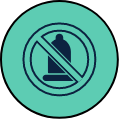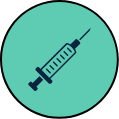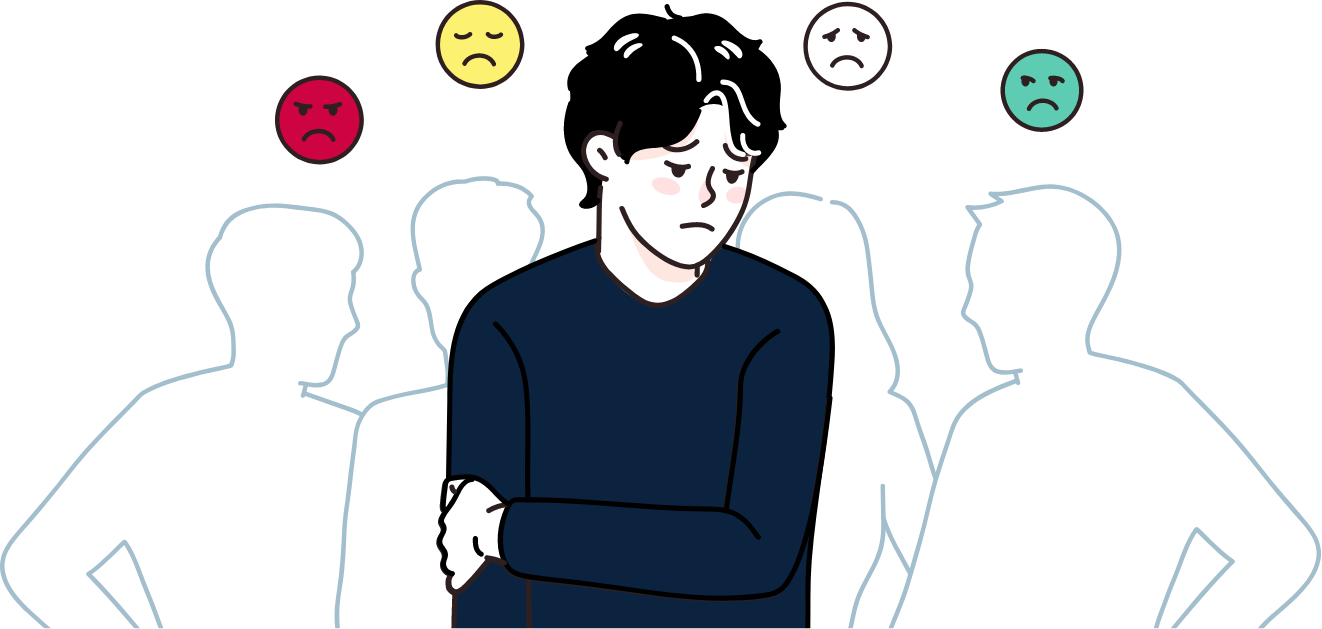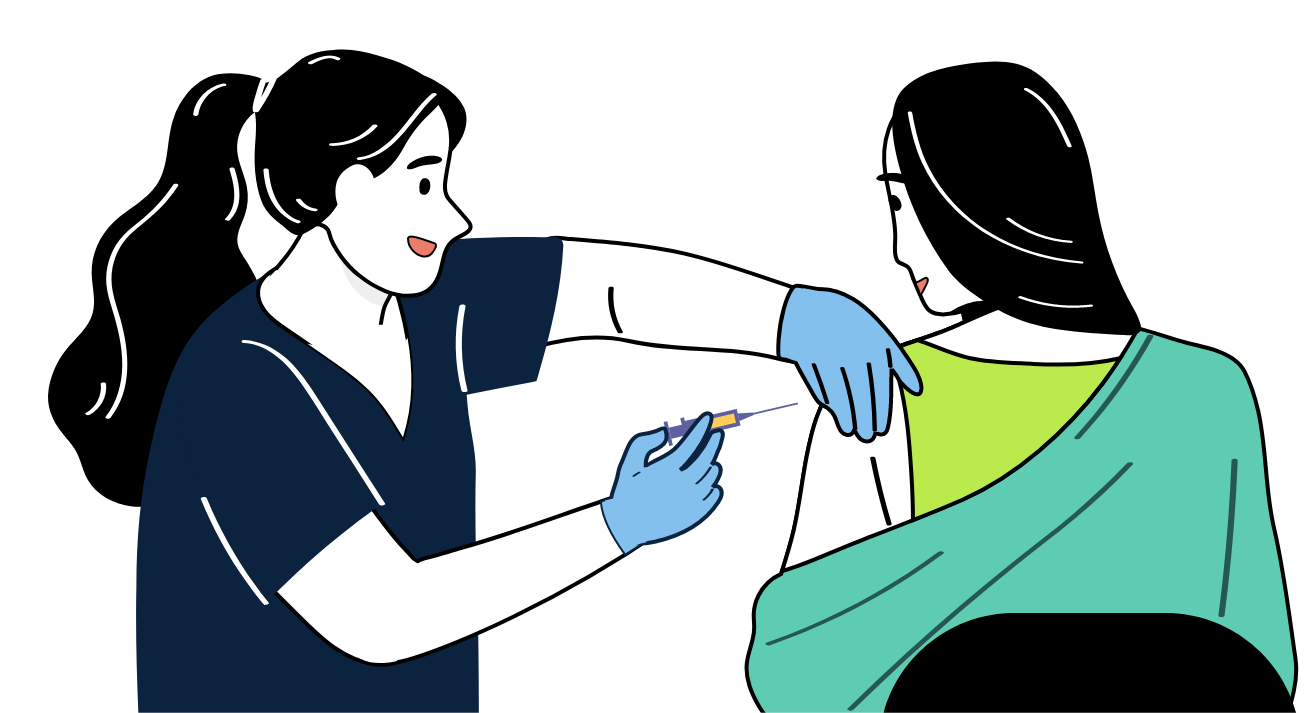KSA-HPV Vaccine Barriers
Motivational barriers are more important than structural barriers1
An online survey study performed in the United States in 2022 among 499 young adults aged 18-35 years old showed that motivational barriers, such as the belief that the vaccine is unnecessary and unreliable, were the highest-ranking barriers and were negatively associated with HPV vaccine intent.1
57.1 %
participants were unlikely to get the HPV vaccine in the next 6 months1
87 %
thought the HPV vaccine was unnecessary
69 %
thought the HPV vaccine was not safe
A cross-sectional survey study was conducted to add to the literature historically focused on college-enrolled populations and to report on barriers to HPV vaccine uptake among young adults recruited via social media channels and clinics. An inclusive outreach strategy, such as Facebook advertisements and outreach with clinics and organizations serving young adults, was used to recruit participants to the study. Facebook advertisements were only shown to United States users aged 18-35 years from June 18, 2019 to March 05, 2020. 598 eligible participants were included to the study. Inclusion criteria were being aged 18-35 years, being un-vaccinated for HPV, being HPV vaccine-eligible, being able to complete an online survey in English, and living in the US. Those meeting eligibility criteria were offered the survey after receiving online consents. 548 participants were completed the survey. Since the study examined vaccination barriers, respondents who had never heard of the HPV vaccine were excluded from the analysis survey (n=41). The main outcome was likelihood of getting the HPV vaccine in the next six months (not at all likely, a little likely, somewhat likely, very likely) and the main independent variable of interest was barriers to HPV vaccination. 12 barriers were asked and open text responses were allowed.1
On the other hand, structural barriers such as insurance or transportation were not listed as high-priority barriers and, therefore may be less important than motivational barriers.1
Patient knowledge, attitudes, and beliefs about human papillomavirus (HPV) and HPV vaccination
Two qualitative studies to examine attitudes and barriers about HPV and HPV vaccination among women and men since The Advisory Committee on Immunization Practices (ACIP) issued recommendations for shared clinical decision-making for 27- to 45-year-olds were performed in 2022 and 2023.2

The study with mid-adult women interviewed 52 participants in eight virtual focus groups,2 and the one with mid-adult men interviewed 34 participants in six virtual focus groups.3
Results

Several key concerns emerged from the qualitative data as barriers to HPV vaccine uptake.2,3
Young adults aged 18-35 also reported similar HPV vaccine uptake barriers.1
Taking a deeper look at the common barriers to HPV vaccine uptake2,3
Barrier 1
Low awareness and limited knowledge about HPV and vaccine eligibility
Most participants reported that they were aware that…

HPV was transmitted via “unsafe sex”3

HPV caused genital warts3

HPV vaccine is recommended for teenagers3
…but most participants are unaware that

HPV can be transmitted via sexual skin-to-skin contact alone3

HPV-related cancers can affect men3

HPV vaccine had been FDA-approved and is eligible for adults through age 452,3
Majority of people residing in Eastern Mediterranean countries were unaware of the availability of the HPV vaccine.4
Barrier 2
Concerns about HPV vaccine side effects and safety
Many participants raised concerns about HPV vaccine-related side effects and long-term safety profile, feeling that HPV vaccines were “new” and may negatively impact reproductive capacity5,6
“There is not enough long-term data for me to feel like I was making the right choice by taking the vaccine.”


With more than 135 million doses distributed in the United States, HPV vaccine has a reassuring safety record that is backed by over 15 years of monitoring and research.5
HPV vaccines are not associated to infertility, but HPV-associated cancers and precancers will need treatment that can sometimes limit the ability to have children.6
Barrier 3
Embarrassment and stigma surrounding HPV vaccination
There is a critical need for accurate information to address salient barriers to HPV and HPV vaccination targeted at women aged 27-45 years as the perceived stigma attached to the sexual nature of HPV keeps women from getting vaccinated against HPV.2

- Stigma regarding HPV is prevalent in male participants concerned that their friends, family, or healthcare providers might assume they were promiscuous if they were to seek HPV vaccination.3
- Some were also of the opinion that HPV vaccination was only necessary for people with multiple concurrent sexual partners.3
sexually active people will be infected with HPV in their lifetime,6 and patients can still be at risk even if they only have one sexual partner, because they may have been infected by a previous partner a long time ago but showed no symptoms.7
Barrier 4
Perceptions of HPV as a “women’s only” disease
Men had low knowledge and awareness about HPV vaccination and perceived HPV to be a “women’s only” disease despite HPV vaccines having been recommended for males by the Food and Drug Administration (FDA) since 2011.3

Upon learning that HPV vaccination can prevent HPV-associated cancers such as oropharyngeal, anal, and penile cancer, several participants reported being open to getting vaccinated.3
Barrier 5
Lack of recommendation from healthcare providers (HCP)
Though most participants see HCPs as trusted sources of HPV vaccine information, they had never discussed HPV vaccination with an HCP.3
After learning HPV vaccination is recommended and approved for adults up to age 45, many participants expressed surprise that HPV vaccination had never been recommended to them by their doctors.3
“A doctor’s recommendation would be very influential in my decision to get the vaccine.”3

Abbreviations:
ACIP = The Advisory Committee on Immunization Practices
FDA = Food and Drug Administration
HCP = healthcare providers
HPV = human papillomavirus
REFERENCES
- Muthukrishnan M, Loux T, Shacham E, Tiro JA, Arnold LD. Barriers to human papillomavirus (HPV) vaccination among young adults, aged 18–35. Preventive Medicine Reports 2022;29:101942.
- Polonijo AN, Mahapatra D, Brown B. “I Thought It Was Just For Teenagers”: Knowledge, Attitudes, and Beliefs about HPV Vaccination Among Women Aged 27 to 45. Women’s Health Issues 2022;32-3:301–308.
- Alaraj RA, Brown B, Polonijo AN. “If People Were Told About the Cancer, They’d Want to Get Vaccinated”: Knowledge, Attitudes, and Beliefs About HPV Vaccination Among Mid-Adult Men. Am J Mens Health. 2023;17(1):15579883231153310.
- Hakimi S, Lami F, Allahqoli L, Alkatout I. Barriers to the HPV vaccination program in the Eastern Mediterranean region: a narrative review. J Turk Ger Gynecol Assoc. 2023;24:48-56.
- Government of Canada. Human papillomavirus (HPV) vaccines: Canadian Immunization Guide. https://www.canada.ca/en/public-health/services/publications/healthy-living/canadian-immunization-guide-part-4-active-vaccines.html Accessed February 12, 2025.
- CDC Fact Sheet. HPV Vaccine is Cancer Prevention. 2021. https://www.cdc.gov/vaccines/partners/downloads/teens/vaccine-safety.pdf. Accessed February 12, 2025.
- World Health Organization. Questions and answers about HPV vaccination. http://www.euro.who.int/__data/assets/pdf_file/0009/356841/Q-and-A_HPV_Parents_EN.pdf. Accessed February 12, 2025.
Selected Safety Information of Gardasil™
GARDASIL [HUMAN PAPILLOMAVIRUS QUADRIVALENT (TYPES 6,11,16,18) RECOMBINANT VACCINE]
Therapeutic indications
Gardasil is a vaccine for use from the age of 9 years for the prevention of:
- Premalignant genital lesions (cervical, vulvar and vaginal), premalignant anal lesions, cervical cancers and anal cancers causally related to certain oncogenic Human Papillomavirus (HPV) types.
- Genital warts (condyloma acuminata) causally related to specific HPV types.
The use of Gardasil should be in accordance with official recommendations.
Posology and method of administration
Posology
Individuals 9 to and including 13 years of age
Gardasil can be administered according to a 2-dose schedule (0.5 ml at 0, 6 months).
If the second vaccine dose is administered earlier than 6 months after the first dose, a third dose should always be administered.
Alternatively, Gardasil can be administered according to a 3-dose (0.5 ml at 0, 2, 6 months) schedule. The second dose should be administered at least one month after the first dose and the third dose should be administered at least 3 months after the second dose. All three doses should be given within a 1-year period.
Individuals 14 years of age and older
Gardasil should be administered according to a 3-dose (0.5 ml at 0, 2, 6 months) schedule.
The second dose should be administered at least one month after the first dose and the third dose should be administered at least 3 months after the second dose. All three doses should be given within a 1-year period.
The use of Gardasil should be in accordance with official recommendations.
Paediatric population
The safety and efficacy of Gardasil in children below 9 years of age have not been established. No data are available.
It is recommended that individuals who receive a first dose of Gardasil complete the vaccination course with Gardasil.
The need for a booster dose has not been established.
Method of administration
The vaccine should be administered by intramuscular injection. The preferred site is the deltoid area of the upper arm or in the higher anterolateral area of the thigh.
Gardasil must not be injected intravascularly. Neither subcutaneous nor intradermal administration has been studied. These methods of administration are not recommended.
Contraindications
- Hypersensitivity to the active substances or to any of the excipients.
- Individuals who develop symptoms indicative of hypersensitivity after receiving a dose of Gardasil should not receive further doses of Gardasil.
- Administration of Gardasil should be postponed in individuals suffering from an acute severe febrile illness. However, the presence of a minor infection, such as a mild upper respiratory tract infection or low-grade fever, is not a contraindication for immunisation.
Special warnings and precautions for use
Traceability
In order to improve the traceability of biological medicinal products, the name and the batch number of the administered product should be clearly recorded.
The decision to vaccinate an individual should take into account the risk for previous HPV exposure and potential benefit from vaccination.
As with all injectable vaccines, appropriate medical treatment should always be readily available in case of rare anaphylactic reactions following the administration of the vaccine.
Syncope (fainting), sometimes associated with falling, can occur following, or even before, any vaccination, especially in adolescents as a psychogenic response to the needle injection. This can be accompanied by several neurological signs such as transient visual disturbance, paraesthesia, and tonic-clonic limb movements during recovery. Therefore, vaccinees should be observed for approximately 15 minutes after vaccine administration. It is important that procedures are in place to avoid injury from faints.
As with any vaccine, vaccination with Gardasil may not result in protection in all vaccine recipients.
Gardasil will only protect against diseases that are caused by HPV types 6, 11, 16 and 18 and to a limited extent against diseases caused by certain related HPV types. Therefore, appropriate precautions against sexually transmitted diseases should continue to be used.
Gardasil is for prophylactic use only and has no effect on active HPV infections or established clinical disease. Gardasil has not been shown to have a therapeutic effect. The vaccine is therefore, not indicated for treatment of cervical cancer, high-grade cervical, vulvar, and vaginal dysplastic lesions or genital warts. It is also not intended to prevent progression of other established HPV-related lesions.
Gardasil does not prevent lesions due to a vaccine HPV type in individuals infected with that HPV type at the time of vaccination.
The use of Gardasil in adult women should take into consideration the variability of HPV type prevalence in different geographical areas.
Vaccination is not a substitute for routine cervical screening. Since no vaccine is 100 % effective and Gardasil will not provide protection against every HPV type, or against existing HPV infections, routine cervical screening remains critically important and should follow local recommendations.
Safety and immunogenicity of the vaccine have been assessed in individuals aged from 7 to 12 years who are known to be infected with human immunodeficiency virus (HIV).
Individuals with impaired immune responsiveness, due to either the use of potent immunosuppressive therapy, a genetic defect, or other causes, may not respond to the vaccine.
This vaccine should be given with caution to individuals with thrombocytopaenia or any coagulation disorder because bleeding may occur following an intramuscular administration in these individuals.
Long-term follow-up studies were conducted to determine the duration of protection.
There are no safety, immunogenicity or efficacy data to support change during vaccination with Gardasil to other HPV vaccines which do not cover the same HPV types. Therefore, it is important that the same vaccine should be prescribed for the whole dose regimen.
Sodium
This medicinal product contains less than 1 mmol sodium (23 mg) per dose, that is to say essentially ‘sodium-free’.
Interaction with other medicinal products and other forms of interaction
In all clinical trials, individuals who had received immunoglobulin or blood-derived products during the 6 months prior to the first vaccine dose were excluded.
Use with other vaccines
Administration of Gardasil at the same time (but, for injected vaccines, at a different injection site) as hepatitis B (recombinant) vaccine did not interfere with the immune response to the HPV types. The seroprotection rates (proportion of individuals reaching seroprotective level anti-HBs >10 mIU/ml) were unaffected (96.5 % for concomitant vaccination and 97.5 % for hepatitis B vaccine only). Anti-HBs geometric mean antibody titres were lower on co-administration, but the clinical significance of this observation is not known.
Gardasil may be administered concomitantly with a combined booster vaccine containing diphtheria (d)and tetanus (T) with either pertussis [acellular, component] (ap) and/or poliomyelitis [inactivated] (IPV) (dTap, dT-IPV, dTap-IPV vaccines) with no significant interference with antibody response to any of the components of either vaccine. However, a trend of lower anti-HPV GMTs was observed in the concomitant group. The clinical significance of this observation is not known. This is based on the results from a clinical trial in which a combined dTap-IPV vaccine was administered concomitantly with the first dose of Gardasil.
The concomitant administration of Gardasil with vaccines other than the ones above has not been studied.
Use with hormonal contraceptives
In clinical studies, 57.5 % of women aged 16 to 26 years and 31.2 % of women aged 24 to 45 years who received Gardasil used hormonal contraceptives during the vaccination period. Use of hormonal contraceptives did not appear to affect the immune response to Gardasil.
Fertility, pregnancy and lactation
Pregnancy
Specific studies of the vaccine in pregnant women were not conducted. During the clinical development program, 3,819 women (vaccine = 1,894 vs. placebo = 1,925) reported at least one pregnancy. There were no significant differences in types of anomalies or proportion of pregnancies with an adverse outcome in Gardasil and placebo treated individuals. These data on pregnant women (more than 1,000 exposed outcomes) indicate no malformative nor feto/ neonatal toxicity.
The data on Gardasil administered during pregnancy did not indicate any safety signal. However, these data are insufficient to recommend use of Gardasil during pregnancy. Vaccination should be postponed until completion of pregnancy.
Breast-feeding
In breast-feeding mothers given Gardasil or placebo during the vaccination period of the clinical trials the rates of adverse reactions in the mother and the breast-fed infant were comparable between the vaccination and the placebo groups. In addition, vaccine immunogenicity was comparable among breast-feeding mothers and women who did not breast-feed during the vaccine administration.
Therefore, Gardasil can be used during breast-feeding.
Fertility
Animal studies do not indicate direct or indirect harmful effects with respect to reproductive toxicity. No effects on male fertility were observed in rats.
Effects on ability to drive and use machines
No studies on the effects on the ability to drive and use machines have been performed.
Undesirable effects
A. Summary of the safety profile
In 7 clinical trials (6 placebo-controlled), individuals were administered Gardasil or placebo on the day of enrolment and approximately 2 and 6 months thereafter. Few individuals (0.2 %) discontinued due to adverse reactions. Safety was evaluated in either the entire study population (6 studies) or in a predefined subset (one study) of the study population using vaccination report card (VRC)-aided surveillance for 14 days after each injection of Gardasil or placebo. The individuals who were monitored using VRC-aided surveillance included 10,088 individuals (6,995 females 9 to 45 years of age and 3,093 males 9 to 26 years of age at enrolment) who received Gardasil and 7,995 individuals (5,692 females and 2,303 males) who received placebo. The most common adverse reactions observed were injection-site adverse reactions (77.1 % of vaccinees within 5 days following any vaccination visit) and headache (16.6 % of the vaccinees). These adverse reactions usually were mild or moderate in intensity.
B. Tabulated summary of adverse reactions
Clinical Trials
Table 1 presents vaccine-related adverse reactions which were observed among recipients of Gardasil at a frequency of at least 1.0 % and also at a greater frequency than observed among placebo recipients. They are ranked under headings of frequency using the following convention:
[Very Common (≥1/10); Common (≥1/100 to <1/10); Uncommon (≥1/1,000 to <1/100); Rare (≥1/10,000 to <1/1,000); Very Rare (<1/10,000)]
Post-Marketing Experience
Table 1 also includes additional adverse events which have been spontaneously reported during the post-marketing use of Gardasil worldwide. Because these events are reported voluntarily from a population of uncertain size, it is not always possible to reliably estimate their frequency or establish a causal relationship to vaccine exposure. Consequently, the frequency of these adverse events is qualified as “not known”.
Table 1: Adverse Events Following Administration of Gardasil from Clinical Trials and Post-Marketing Surveillance

*Post Marketing adverse events (frequency cannot be estimated from the available data).
1 During clinical trials, dizziness was observed as a common adverse reaction in females. In males, dizziness was not observed at a greater frequency in vaccine recipients than in placebo recipients.
In addition, in clinical trials adverse reactions that were judged to be vaccine- or placebo-related by the study investigator were observed at frequencies lower than 1 %:
Respiratory, thoracic and mediastinal disorders:
Very rare: bronchospasm.
Skin and subcutaneous tissue disorders:
Rare: urticaria.
Nine cases (0.06 %) of urticaria were reported in the Gardasil group and 20 cases (0.15 %) were seen in the adjuvant-containing placebo group.
In the clinical studies, individuals in the Safety Population reported any new medical conditions during the follow-up. Among 15,706 individuals who received Gardasil and 13,617 individuals who received placebo, there were 39 cases of non-specific arthritis/arthropathy reported, 24 in the Gardasil group and 15 in the placebo group.
In a clinical trial of 843 healthy adolescent males and females 11-17 years of age, administration of the first dose of Gardasil concomitantly with a combined diphtheria, tetanus, pertussis [acellular, component] and poliomyelitis [inactivated] booster vaccine showed that there was more injection-site swelling and headache reported following concomitant administration. The differences observed were < 10 % and in the majority of subjects, the adverse events were reported as mild to moderate in intensity.
Overdose
There have been reports of administration of higher than recommended doses of Gardasil. In general, the adverse event profile reported with overdose was comparable to recommended single doses of Gardasil.
SA-HPV-00073 | Expiry Date: 02-12-2026
